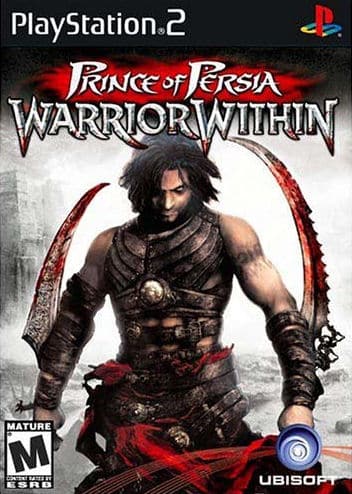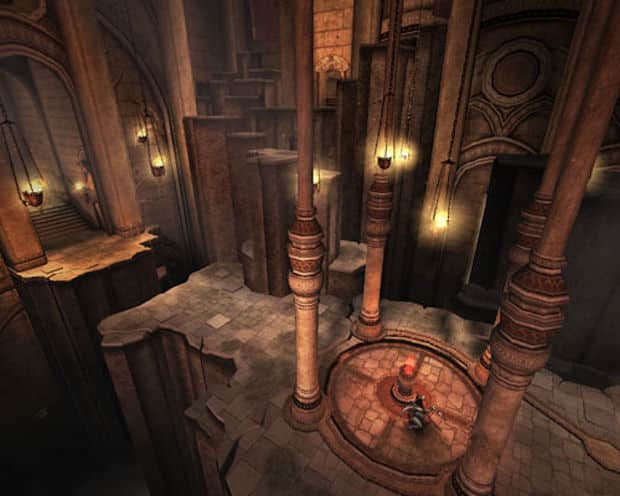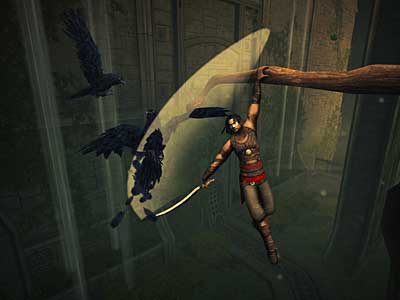
Caught in a rough storm, flaming arrows strike the hull of his ship, the Prince prompts the crew ready for battle as large hooks draw in a neighbouring ship. The opposing vessel reels in, revealing a number of savage creatures equipped with swords readied for combat. A dark haired lady, clad in the minimalist seasonal dominatrix wear, almost posing for the suggestive camera angles, enters the pack before demanding the Prince be killed. The savages cross ship on her command, hungry for blood. The Prince leaps some railings, entering the scene like a stallion and the gameplay begins. Before you can even press a button though, two enemies begin attacking at either side, no less than a second after the game opens. Button mashing is a good retaliation, supported by the aggravated growls of the Prince and the dry rebuttals of the mob as he assaults the fodder with his blade. A few bloody finishers later and another cutscene triggers, sending the Prince into the lower docks. He rises, power chords crunch in and the slaughter continues, this time he’s given a pole to spin around, slicing heads in glorious slow motion – lots of blood. Eventually he makes his way to the ship’s head, another brief cutscene triggers, the dominatrix chick steps in front of the camera fortify the foregrounded Prince with the sexual insinuation of her thighs. The Prince, now furious ascends the stairs. The two duel, another sporadic cutscene hits, this time he calls her a bitch, she bites back with some nonsense. The dominatrix lady kicks him into the water and here begins Prince of Persia: Warrior Within.
System: PlayStation 2, GameCube, Xbox, Microsoft Windows PC and PSP (title Prince of Persia: Revelations)
Genre: Adventure, Platforming
Release date: December 2, 2004 (December 6, 2005 on PSP)
Players: 1
Developer: Ubisoft Montreal
Publisher: Ubisoft
Origin: Canada
A trailer hyping the Prince of Persia: Warrior Within.
In my first play through of this opening sequence, the Prince snarled one of his oft-spoken lines “You will pay for this transgression”. Such lines are repeated ad nauseam throughout the game’s frequent combat sections. No doubt, Warrior Within paid handsomely for Ubisoft’s owns transgressions; a huge talking point for this review. Warrior Within, if you’re unfamiliar with, is the dark haired mope, the crow on the otherwise charming Prince of Persia family tree. Following the lack of commercial success of The Sands of Time, Ubisoft decided to reinvent the Prince with a darker, more “mature” attitude in the hopes of achieving greater sales numbers. Ultimately Ubisoft’s intentions ensued in positive sale numbers, yet at the dire cost of the franchise’s reputation. Warrior Within isn’t just a darker divergence in the series, it’s a destruction of franchise ideals, replaced instead with manufactured maturity and “coolness” to appease the adolescent crowd.

Warrior Within takes bickering dialogue, bloody decapitations and ridiculously large dominatrix boobies in it’s stride, all to the tune of ear-bleeding Godsmack music. Did I mention he’s got tats too?
Yes, this is the new Prince of Persia; a long departure from the good-willed, charming heroics of Jordan Mechner’s classic persona. Instead the titular hero is replaced by an angry, soulless pup who looks daft enough to front any rock/metal band in this post-Cobain era. His motives for retribution: to save his own ass, make it difficult to sympathize, let alone care about the cardboard personality. The female characters and their transparent chest supports are equally painful to watch. For the most part the narrative and cast are forgettable, at worst, they induce cringed faces, save for some well thought out time folding tricks nearing the tail end of the adventure – better than Sands of Time’s narrative tricks actually. Unfortunately the narrative ingenuity results in copious amounts of unnecessary backtracking.
The entire game is overcast by the generically aggressive male persona of the Prince. The environments, previously filled with whimsy and wonder, with delightful use of colour and particle effects is reduced to an overabundance of anything dark and brooding. This is particularly troublesome on CRT-technology TVs and even more of an issue in the PlayStation 2 version. I was forced to turn up the brightness of my TV in order just to see where I was going on screen.
Each area of the game is drenched in an over saturation of colour. Walking between one door way into another will occasionally spark a sharp transition between the colour filters. One moment the game world will be draped in goldy yellows and browns, then suddenly lapse into pure green, red, or dark blue. The vivid colouring is effective, but at the same time problematic. Firstly, it’s too distinct, particularly in the garden levels the screen appears almost blanketed by a solid fill of green. This, in turn, subdues the other colours and lessens the overall visual quality. Secondly the aforementioned transitions between filters only highlights this issue. In the same vein as the angst atmosphere, even the colour is overdone. These issues put a damper on an otherwise strong visual design which is up to par, if not exceeding the original Sands of Time. The environments are far more elaborated, twisting in and around the natural earth to creative another visually provocative experience.

Warrior Within introduces a new time travel component where the Prince can switch between past and present on entering time portals scattered throughout the island. Thankfully, despite the addition, Warrior Within retains the linear progression of the original, save for a crossroads early on in the game. The time travel mechanic, while perhaps an unsurprising addition, lends a surprising amount of versatility to the design, making itself a welcomed addition. For one, it allows the visuals to be remade between periods. In the past, the palace and surrounding areas were well-kept, colourful even. In the present, the environment has seen severe decay and overgrowth. Either time period splinters off the areas in which the Prince can traverse. For example, there may be an inaccessible platform in the past that overgrowth in present may provide access to. Upon reaching this platform and exploring this new area to its end, the Prince can activate another time portal and shift back into the past to explore the previously secluded area in a reimagined state. Such a function could result in excess amounts of backtracking, but is masterfully handled. The rejigged environments rarely feel the same, let alone similar because 1) you’re exploring them from back to front (rather than front to back) 2) they’ve been modified considerably, providing different means to the same end 3) the visual disparity between periods. The levels in Warrior Within are themselves multi-faceted in that they allow operation from both ends, coming and going within the same level. The time traveling mechanic layers on top of this already folded approach to level design to create an even more organic system of play. So while the game’s character might be rather tarnished, the design qualities from Sands of Time have carried over to greater fruition.
Activating and entering a portal for the first time will grant the Prince extra abilities. It’s a rather uninspired way to hand the player new skills, but it’s works, even if the majority of new moves are useless. Once you gain the necessities from Sands of Time, the other additions are all combat techniques which the player most likely won’t bother to familiarize themselves with. With some crafty investigation, the Prince can also uncover health upgrades stowed away in hidden chambers. It’s usually a rocky road to get there, but the upgrades are worth the extra effort.
This leads me to the uneventful, yet much touted “free-form” combat system. Combat has always been the weakest part of the Prince of Persia games – a novel distractions, hindering access to the wonderful platforming sections. Due to the “mature” vibe of Warrior Within, the game is top loaded with combat wherever the game can squeeze it in. I’m a little dumbfounded as to why they still bother including combat in the Prince of Persia games. Warrior Within doesn’t persuade me much either. The overall combat system is largely derived from Sands of Time; the Prince can chain basic combos, vault over enemies, strafe etc. This time a few supportive mechanics are added, the Prince can now pick up a second, dropped weapon and use it in battle. Supposedly it changes up the combat, I didn’t notice it much. The peripheral weapon can also be used as a projectile. The Prince can now restrain an enemy from behind (usually by first vaulting over) in a close quarters fashion, ala Metal Gear Solid 3. Once in a lock the Prince can press another button to unleash a distastefully violent finisher, such as strangulation or decapitation. Sometimes the game will showcase these moves in glorious slow motion (you can toggle the amount of slow-mo through the options menu too, hmmm…). There’s a hoist of specialty moves added as well – most of them gained through the time portals – which I almost never used.
Prince of Persia: Warrior Within “Free Form Fighting Trailer”.
The combat is terribly lethargic and drawn out, unassisted by the new additions. I preferred the way Sands of Time tightroped the combat and platforming. Very simple: you enter a room, wave your sword about, cutscene triggers, you may continue platforming. Warrior Within is quick to wrongfully tinker with this system and liberally spreads hoards of monsters between platforming sections. You know, the Prince is all grown-up now, which means he must constantly engage in tiresome blood-letting sequences. This would be fine if the enemy set were the tepid type which you could briskly waste away. But unfortunately they’re not. The cast of assassins, beasts and dominatrix ninjas are as brutally unforgiving and gratuitous as the constant stream of shallow maturity, spewed out by the narrative. The Prince can usually only land a blow or two before enemies block, you wait a few second before they ease, allowing for the cycle to continue. The new abilities do little to break apart the grindy procedure that this eventually amounts to. Enemies can often take huge amounts of pain, so you’ll have to spend ages socking them about, only exacerbating the frustration. I found, combo-ing with the basic attack variations, dodging and then combo-ing again usually does the trick. The instruction manual and in-game tutorials are keen to point out the move list, yet with combos like square button + square button + square button + square button. It’s difficult to take any of it seriously.
Frequently the game will cheaply lengthen difficulty by flooding you with 4-6 enemies in the one scenario, making it difficult to navigate and manage each of the combatants, let alone flee. This latter point is perhaps the most integral since you’ll often try to avoid confrontation, working against the game’s mechanical nature. In Sands of Time, the Prince could alternate between combat and platforming modes by withdrawing or retiring his blade at the press of a button. As Warrior Within assigns that button to the projectile moves, the switch between modes is automated. In fact for the most part the Prince’s sword(s) remain drawn. Being automatically thrown into combat mode is a frustrating affair as it centralizes the Prince’s movement to the closest enemy, effectively pacing down his escape. Even worse, instead of wall jumping, the Prince will often leap off the wall, lunging towards X enemy in close proximity, rather than jump straight up. This issue, along with the unfair combat makes it an inescapable frustration, rammed down your throat. Along with the depressing narrative, the combat is a tough pill to swallow to access the sublime platforming.
There’s little reason to partake in combat, it’s just a huge roadblock that wears out its welcome very quickly. I recommend avoiding any confrontations unless absolutely necessary (ie. for sand tank refills), and to opt for the easiest difficulty, as even on normal the game is needlessly unfair and punishing.

The platformer challenges demand the player think two steps ahead at all time with lengthier sections without respite. Juggling the climbable hotspots while in acrobatic limbo is impossible, players need to think carefully and quickly in order to proceed. Sands of Time rarely forced the players to exert themselves so much, but such is a regular occurrence in Warrior Within, so prepare for it. There are also sequences where the Prince runs into the Dahaka, in which he must quickly escape. These sequences build up the intensity of the platforming. No doubt Warrior Within will scratch the itch for those who wanted more from Sands of Time’s platforming.
The challenging platforming is met with fewer, more distant checkpoints as well as no hint system as seen in the Prince’s flashbacks during Sands of Time.
Lastly, it needs to be said that, while still a polished title, Warrior Within is far less polished than its forebearer with occasional glitches, slow down and frame rate dilemmas. This is more prevalent in the PS2 version, supposedly. The sound transitions as well as the filtering pop in and out too.
In concluding, if you can bear this beloved franchise selling out to the masses and losing its all important soul, then Warrior Within is a solid action game with lame, overabundant combat and superb platforming sequences. Fans of the series’ acrobatics will get a thorough workout with this title, which is incentive enough to pick it up, otherwise newbies, or those looking for a single round of Prince of Persia should invest in The Sands of Time.
FUN FACTOR: 7
Platforming, superior on all counts to Sands of Time, if not a little too challenging at times. The combat drags the enjoyment down considerably, although can be enjoyable in small doses.
Graphics: 7
Loses the charm and whimsy of the earlier games. Still, behind the filtering issues, severe bouts of darkness and constant black or goldy brown aesthetic, the game maintains a strong artistic impression.
Audio: 3
There’s a reason why I didn’t mention this in the bulk of the review; guitar riffs poison the ears, make them stop please. Prince’s dialogue is gruff lumped with traditional tongue, rather fowl.
Ingenuity: 8
The minor additions such as the split world, time traveling mechanic only heighten an already fantastic framework.
Replay Value: 7
A much more endearing adventure than The Sands of Time, perhaps too long at up to 20 hours depending on your skill. The length becomes rather contrived at the end, but it’s still a wholesome package.
